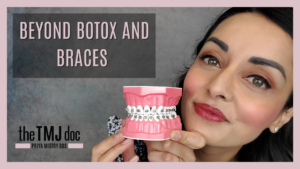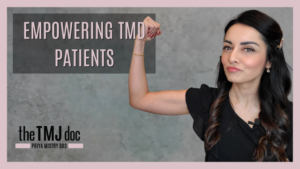Why See TMJ Dentist?
If you have TMJ Disorder (TMJ/TMD), seeking the care of a qualified TMJ Provider is incredibly important. Unfortunately, not every practitioner is trained to treat this condition mainly because diagnosis and treatment of TMJ/TMD is largely not taught in medical or dental schools. This makes it difficult to find a provider who treats TMJ/TMD effectively! Dr. Priya Mistry has limited her practice to taking care of those with TMJ/TMD and celebrates a 90% success rate with her unique treatment modalities! At her office (located in Vancouver, WA), you will receive the highest quality of care to help regain your quality of life and experience lasting relief!
What is a TMJ Dentist?
As a TMJ Dentist, Dr. Mistry takes a “big picture” view your jaw joints, muscles, posture, bite, and more to bring the jaw joints and muscles to a healthy, functional state. This involves finding the optimal alignment of your jaw in relation to your head and neck. Finding this optimal alignment brings harmony to your jaw, relieving TMJ/TMD symptoms, including pain (ranging from mild to severe) and dysfunction.
Dr. Mistry understands that jaw function impacts your overall wellness and ability to get through the day when pain is at its worst. She also understands that having poor jaw position can impact your posture, your neck, and your spine.
Technology Used to Diagnose and Treat TMJ Disorder
Dr. Mistry’s treatment modalities relieve pressure on the jaw joints and the muscles that surround the support the jaw – ultimately reducing pain and inflammation by putting the muscles in their most relaxed position (their correct resting length, decompressing the joints, and increasing blood flow to the problem area.
TMJ/TMD treatment often includes wearing a TMJ orthotic in addition to hands-on therapy performed by Dr. Mistry herself. She also utilizes TekScan (T Scan) and DTR (Disclusion Time Reduction) Therapy for those who are candidates. Learn more about TMJ/TMD treatment and plan your path to a pain-free life today!
The Importance of TMJ Treatment
If you suffer from TMJ/TMD, you cannot merely “tough it out” or hope that the condition goes away. In fact, failing to seek diagnosis and treatment can exacerbate the symptoms of TMJ/TMD. While the symptoms of this condition vary, TMJ Disorder frequently causes pain—often chronic and severe in nature. It can be bad enough to impede your ability to function on a daily basis and complete seemingly simple tasks. Left undiagnosed or untreated, TMJ Disorder may manifest pain in other areas of the body.
Phase 1 and Phase 2 TMJ/TMD Treatment
Traditionally, orthotic therapy involved wearing a TMJ orthotic 24/7, even when eating for at least 3-4 months OR until symptoms resolved. Wearing the orthotic and bringing the muscles and jaw joints to health and function is considered Phase 1 TMJ/TMD treatment. In terms of symptoms, this means eliminating or drastically decreasing headaches, neck pain, jaw pain, ear pain, dizziness, tooth pain, gum pain, jaw joint noises, and/or jaw catching or locking.
Phase 1 TMJ/TMD Treatment was traditionally done WITH the knowledge that the jaw would start to adapt to a different position – the position in which the orthotic was holding the jaw. This means that the bite would be drastically different at the end of orthotic wear than it was at the start of treatment. People would go into this treatment KNOWING they would need Phase 2 treatment – braces or full mouth reconstruction (crowns on every tooth) – afterwards to make their teeth (“bite”) come together again.
Dr. Mistry’s mentor – Dr. Arthur L. Parker – was able to find a way to do Phase 1 treatment for most patients without changing the bite and therefore, without needing Phase 2 treatment. Dr. Mistry celebrates a 90% success rate with Phase 1 TMJ/TMD treatment. Many of her patients do NOT have to move on to Phase 2 treatment as long as they continue to wear the nighttime orthotic indefinitely.
Phase 2 TMJ/TMD Treatment involves moving the teeth to the stable and optimal jaw position found during Phase 1 treatment. This can be done with orthodontia (braces, Invisalign, etc) OR with full mouth reconstruction (crowns on every tooth).
Dr. Mistry does not provide Phase 2 TMJ/TMD treatment in her office simply because the vast majority of her patients do not need it. On behalf of her patients and for those who WANT Phase 2 treatment, Dr. Mistry works with local dentists and/or orthodontists to communicate the optimal jaw position. For Phase 2 TMJ/TMD treatment, the Phase 1 provider MUST work closely with the Phase 2 provider to achieve the best outcome for the patient.
TMJ Dentist in Vancouver, WA
Have more questions about TMJ/TMD or treatment to relieve TMJ Dysfunction? To learn more about the TMJ/TMD treatment offered at Dr. Mistry’s office, click here. Remember that TMJ/TMD is a chronic, progressive disorder and must be treated by a skilled and experienced TMJ practitioner such as Dr. Priya Mistry. Contact The TMJ Doc by calling (503) 255-8293 to schedule your consultation.







